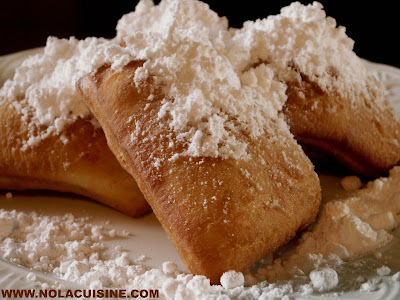 The Bouchon Bakery Vanilla Beignets – an up-to-date version!
The Bouchon Bakery Vanilla Beignets – an up-to-date version!
I have never realized the extent to which a multitude of cultures have food rituals and festivals centered around the upcoming season of Lent. Of course we all know about Mardi Gras and Venice’s Carnivale. But, I didn’t know there are also festivals in Trinadad and Tobago, Martinique, Ecuador, Brazil, Greece, Fasching, Germany, Cologne, Germany, and Sitges, Spain. These celebrations may actually pre-date Roman times and are not limited to areas with a history of dominant Catholic populations. I found one list of the “top 10 Pre-Lenten Celebrations on the link below:
http://travel.nationalgeographic.com/travel/top-10/pre-lenten-carnivals/#page=2
And, here is a more complete list: www.wikipedia.org/wiki/Carnival
Over the last couple of weeks I have begun to see articles and recipes about Mardi Gras in the newspaper and online. There are also many festivals in the US centered around Lent and St. Joseph’s Day which is March 19, another feast to which many pastry-based items are directly tied.
I am amazed at all the information I found on the subject matter of “fried dough” across countries, cultures and time. It’s just a little piece of basically plain dough, isn’t it? Not really…… This is one amazing subject to investigate!! While I originally thought this was a treat of humble origins, born out of poverty and scarcity in western europe (I am always imagining these little old Italian ladies rummaging through their cupboards and trying to concoct some semblance of a meal out of the most frugal and ordinary of ingredients), as so many of our favorite peasant-originated foods are today, it is fascinating to find that the more likely origins are from the highest levels of Islamic culture during the Middle Ages – and are tied to the availability of the appropriate vessels to allow frying in fat at high temperatures which would have only been found at the highest levels of society.
What could be more humble than a piece of fried dough, you ask? Ahhhh, here is a subject you will find the most sophisticated chefs and food lovers gushing and writing about down through history………. Consider their enduring popularity and saturation across cultures and seasons…. Humble but tantalizing, and yes, quite ubiquitous. Today, just in Europe, little puffs of dough are found in this season in England, Holland, Portugal, Germany, Poland, and, of course, Italy and Greece. And, lest you continue to think that all good things continue to be centered in Western Civilizations, consider the list I found in the following: http//en.wikipedia.org/wiki/List_of_fried_dough_foods. That just about covers it, doesn’t it?
There is much controversy and disagreement about the origins of today’s “traditional” beignet, the subject of this post. (I will not even attempt to cover other fried-dough treats here, today – as they are too many and varied.) There is plenty of information about them online and in books. National Geographic even has a page devoted to the origin of the beignet. http://education.nationalgeographic.com/education/media/beignets/?ar_a=1 Interestingly, they apparently descended from an ancient form of dough which eventually evolved into what today we know of as fried choux, that is, a dough which was leavened with eggs and not yeast. Today, however, while both versions can be considered as a beignet, the yeasted version seems to be the more common and popular (perhaps because it more closely resembles a decadent jelly donut??)
Things get murkier here when trying to understand the use of yeast vs eggs: I could not find a definitive description on whether the use of yeast vs eggs was determined by culture and/or the particular “pastry” application. What I did find was that a man named Pantanelli, a member of Catherine deMedici’s court, brought the concept of a choux from Florence to France in 1540, when she went to there to marry the Duke of Orleans who later became King Henry II of France. This seems late to me but it may only be because it is what the dough was known of at that time, and in this very specific form. The dough was re-named, by Avice, a patisserier, who developed “choux buns” and then it became known as Pate-a-Choux, as they resembled cabbages, = choux in French. It is interesting to note that, in its baked form, choux is perhaps equally as popular – as in profiteroles, eclairs, paris brest, etc.. However, the baked form is never considered in the genre of the beignet. (It is interesting to note, however, that there are references to eggs having been used in making dough as long ago as 6000BC.)
There is a wide array of fried dough treats available today in this country, both yeasted and non, and yes, this can truly be considered to be the origin of the American obsession with the doughnut, no? I found the biggest disagreement about their origin here around whether they emigrated first to the eastern coast of Canada or directly to the New Orleans area via the Ursuline nuns, around 1727. Most sources do agree that they originated in the late Middle Ages, probably in Andalusia, most probably sourced from Islamic culture, – via a reference to the dish, “luqam al qadi” in 1226 in The Baghdad Cookery Book, and eventually became known as bunuelo – were indeed formed from a choux, then migrated on to the Mediterranean coast of France and somehow picking up the Celtic “bigne”, meaning “to raise”. The evolution of the word “beignet” is equally as complicated as their story. So choux or not, we’re hooked!
The most definitive and complete resource I came upon is this fabulous paper written by noted food historian Cathy Kaufman (The Historic Table). Take the time to read this! It will give you all the probable twists and turns of the history of this small and delectible morsel:
http://www.rachellaudan.com/2009/07/beignets-and-luqam-thoughts-from-cathy-kaufman.html
As with most pastry treats, time is of the essence with a beignet. There is absolutely no argument that these taste best and are most appealing when they are JUST out of the frier. Yes, it is difficult to achieve this unless you are standing in the kitchen waiting for them to come out, but from a sensory perspective as well as digestive, these are best eaten asap!
While today, the in-season beignet continues to be most associated with Cafe duMonde in New Orleans, there is a lot of fuss about those made by Tom Douglas, at his Lola in Seattle. I am sure you will find a multitude of favorites across the country. Filled, Unfilled? Powdered Sugar or Cinnamon Sugar ….or plain??? Ahhhhh…..the wonders of ingenuity……custards, jelly, cannoli fillings, even meats in Italy…..and on and on…… It appears that the yeast vs no yeast debate continues on in popular culture, and it appears as though this is not part of the evolutionary process of this food item as both yeasted and non-yeasted morsels continue to be available today. (Consider the fact that the use of yeast is found to be used in food and drink preparations for at early as 4000BC via the Egyptians – that is before the origin of any form of written language.)
 Perhaps the most famous – Courtesty Cafe duMonde
Perhaps the most famous – Courtesty Cafe duMonde
Here is one version to try (Courtesy of Nola Cuisine):
 |
| From Nola Cuisine |
New Orleans Style Beignet Recipe
1 Envelope Active Dry Yeast
3/4 Cup Water (110 degrees F)
1/4 Cup Granulated Sugar
1/2 tsp Salt
1 Beaten Egg
1/2 Cup Evaporated Milk
3 1/2 – 3 3/4 Cups A.P. Flour
1/8 Cup Shortening
Vegetable Oil for Frying
Powdered Sugar in a shaker or sifter
Combine the Yeast, Water, and Sugar in the work bowl of a stand mixer fitted with a dough hook (You could also make this in a food processor, or the old fashioned way, by hand). Let this sit until frothy, about 5 minutes, then add the Salt, Egg, and Evaporated Milk. Mix on low speed, then add half of the flour until it starts to come together, then add the shortening. When the shortening is incorporated start adding the remaining flour, a little at a time until most of it is incorporated. At this time I always turn the dough onto a floured bench to finish by hand, just like when I make bread; it’s a touch thing. Knead the dough adding just enough flour as necessary to make a non-sticky, smooth dough. Place the dough into a large oiled bowl, loosely cover and let rise (I made mine last night and let it rise overnight in the refrigerator).
After the dough has doubled in bulk, punch it down and turn it onto a floured surface and roll out into a rectangle that is about 1/2″ thick. With a very sharp knife working at a diagonal to the rectangle, cut into 2″ wide strips. Now cut into diamond shapes by making diagonal cuts in the opposite direction. Place the Beignets on a floured baking sheet to let rise about 40 minutes in a warm place (I place them in a barely warm oven).
When the Beignets have risen, heat 2-3 inches of vegetable oil in a large saucepan to 350-360 degrees. Place 2-3 Beignets into the hot oil at a time, being careful not to smash or deflate them. When they are golden brown, flip them over until golden brown on the other side (They go pretty quickly so start checking them right after they go into the oil). Remove to paper towel lined plates to drain. Serve hot topped with plenty of powdered sugar (because the dough doesn’t contain much sugar, you will want a lot!). Best served with Cafe au Lait. Enjoy!
***************************************************************************************************
At the risk of making this post even longer, I will end here. Make your own search of beignet recipes – and try them in different forms and with different flavor profiles – the ancients incorporated rose and orange blossom water, for instance. In all cases, I think this will be a fun journey through time and in your kitchen (or in your travels). As always, happy eating – but don’t blame me for your waistline! I’m just the writer, you see?